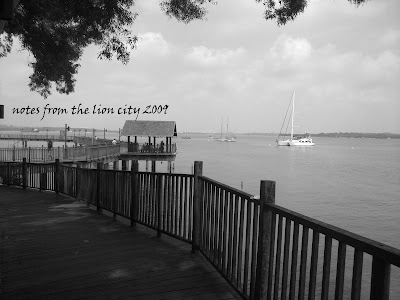 Singapore's public buses are sometimes all dressed up in ads, some even with 3-D installations. Well, this bus's different. It depicts a girl kicking a shuttercock (or better known as chaptek in local lingo), a boy playing a hoop and a kite soaring. Wait a minute, this is no ordinary bus. It's the new heritage bus.
Singapore's public buses are sometimes all dressed up in ads, some even with 3-D installations. Well, this bus's different. It depicts a girl kicking a shuttercock (or better known as chaptek in local lingo), a boy playing a hoop and a kite soaring. Wait a minute, this is no ordinary bus. It's the new heritage bus. There you see it. A bus that's been retrofitted so it's a museum on the inside. Whoa. Is that novel or what? Curiouser and curiouser...
There you see it. A bus that's been retrofitted so it's a museum on the inside. Whoa. Is that novel or what? Curiouser and curiouser... The bus comes with a stock of traditional games that Singaporeans used to play. Clockwise from top left: chaptek, five stones and zero point.
The bus comes with a stock of traditional games that Singaporeans used to play. Clockwise from top left: chaptek, five stones and zero point.Quick glossary:
Chaptek - a feathered thing nailed to a rubber disc that we kick and keep up in the air for as long as possible
Five stones - cloth sewn with beans inside and we play these on a flat surface throwing them onto the surface and then picking and swiping each one or all of them according to a preset pattern with an opponent
Zero-point - A bunch of rubber bands strung to make up a long elastic string, that we used to play a game called zero-point. Just tie them up end to end and perform a series of jumping challenges with your opponent.
I guess it's all kind of Greek to these primary school girls who were invited to the official launch of the heritage bus yesterday at Tanjong Pagar Plaza. Which is why the heritage bus wants to show them the traditional games that their parents played in childhood.
The games provided hours of fun for kids back in the 60s and 70s. They're cheap and fun. No Lego. No computer games. No money to spend on toys. The only masak masak (toys) bought were treats like simple tea sets, or police cuff links and the like..available in the market.
 A text panel on the bus showing the props - Kuti kuti, comprising colourful animals like fish, crab, dragon, etc. It's like collecting trinkets. How to play? The object is to try and flick yours over the opponent's kuti kuti. Whichever kuti kuti lies over the other wins...simple as ABC.
A text panel on the bus showing the props - Kuti kuti, comprising colourful animals like fish, crab, dragon, etc. It's like collecting trinkets. How to play? The object is to try and flick yours over the opponent's kuti kuti. Whichever kuti kuti lies over the other wins...simple as ABC. These fabrics I saw on the bus are used to tailor the traditional dress of the four major ethnic groups in Singapore ie to make (from left) Indian saree, Chinese cheongsam, Malay batik shirt and lace for an English dress (for the Eurasians). In reality, there are further cultural differences between subgroups within each ethnic group.
These fabrics I saw on the bus are used to tailor the traditional dress of the four major ethnic groups in Singapore ie to make (from left) Indian saree, Chinese cheongsam, Malay batik shirt and lace for an English dress (for the Eurasians). In reality, there are further cultural differences between subgroups within each ethnic group.Every ethnic group use spices in their cooking. So let's take a look at a few of the spices displayed on the bus.
 Candlenut or buah keras have been mistaken for macadamia nuts. They're blended with chillis and other ingredients to make the curry paste or rempah. Malays, Peranakans and Eurasians use this ingredient in their curries.
Candlenut or buah keras have been mistaken for macadamia nuts. They're blended with chillis and other ingredients to make the curry paste or rempah. Malays, Peranakans and Eurasians use this ingredient in their curries. People grow curry leaves in their garden or backyard (if you live in a house with a garden) as you only need a few leaves for cooking. Now that most Singaporeans live in high rise flats, we buy them off the shelf.
People grow curry leaves in their garden or backyard (if you live in a house with a garden) as you only need a few leaves for cooking. Now that most Singaporeans live in high rise flats, we buy them off the shelf. There're air holes and so go closer and you can get a whiff of how star anise smells like. The Chinese use this ingredient in their meat stews and the Indians use it with other spices to make garam masala.
There're air holes and so go closer and you can get a whiff of how star anise smells like. The Chinese use this ingredient in their meat stews and the Indians use it with other spices to make garam masala. Nuts of different varieties were sold as snacks by the kacang puteh man, an Indian man who in my mind always wear a dhoti. Just point to the type of nuts you want and he will scoop them out of the air tight jar into rolled up paper cones. So economical and eco-friendly. These ones were for show during the launch yesterday.
Nuts of different varieties were sold as snacks by the kacang puteh man, an Indian man who in my mind always wear a dhoti. Just point to the type of nuts you want and he will scoop them out of the air tight jar into rolled up paper cones. So economical and eco-friendly. These ones were for show during the launch yesterday. There is a cool digital touch screen on board the bus that showcases food from different ethnic groups. The one you see here is a page from the screen that appeared when I selected 'Hainanese chicken rice' from the menu.
There is a cool digital touch screen on board the bus that showcases food from different ethnic groups. The one you see here is a page from the screen that appeared when I selected 'Hainanese chicken rice' from the menu. I thought this bus made by the Tanjong Pagar kindergarten kids for a art competition sums up quite nicely our uniquely Singaporean multicultural people and heritage.
I thought this bus made by the Tanjong Pagar kindergarten kids for a art competition sums up quite nicely our uniquely Singaporean multicultural people and heritage.Do you have a mobile museum where you live?
That's my World



































